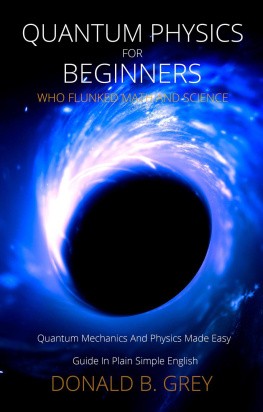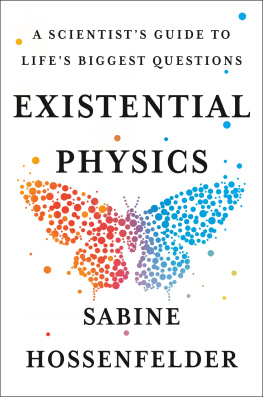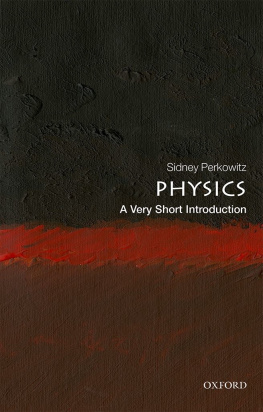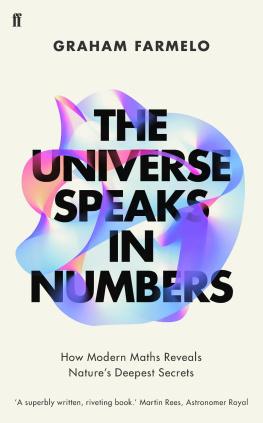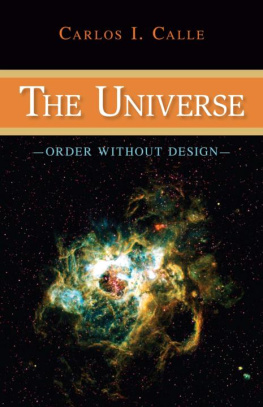Copyright 2019 by Graham Farmelo
Cover design by Ann Kirchner
Cover image copyright Andrew J. Hanson, Indiana University
Cover copyright 2019 Hachette Book Group, Inc.
Hachette Book Group supports the right to free expression and the value of copyright. The purpose of copyright is to encourage writers and artists to produce the creative works that enrich our culture.
The scanning, uploading, and distribution of this book without permission is a theft of the authors intellectual property. If you would like permission to use material from the book (other than for review purposes), please contact permissions@hbgusa.com. Thank you for your support of the authors rights.
Basic Books
Hachette Book Group
1290 Avenue of the Americas, New York, NY 10104
www.basicbooks.com
First Edition: May 2019
Published by Basic Books, an imprint of Perseus Books, LLC, a subsidiary of Hachette Book Group, Inc. The Basic Books name and logo is a trademark of the Hachette Book Group.
The Hachette Speakers Bureau provides a wide range of authors for speaking events. To find out more, go to www.hachettespeakersbureau.com or call (866) 376-6591.
The publisher is not responsible for websites (or their content) that are not owned by the publisher.
The Library of Congress has cataloged the hardcover edition as follows:
Names: Farmelo, Graham, author.
Title: The universe speaks in numbers : how modern math reveals natures deepest secrets / Graham Farmelo.
Description: New York : Basic Books, [2019] | Includes bibliographical references and index.
Identifiers: LCCN 2018053533 (print) | LCCN 2018060165 (ebook) | ISBN9781541673922 (ebook) | ISBN 9780465056651 (hardcover)
Subjects: LCSH: MathematicsMethodology. | PhysicsPhilosophy. | Mathematical physics.
Classification: LCC QC6 (ebook) | LCC QC6 .F3375 2019 (print) | DDC
530.01dc23
LC record available at https://lccn.loc.gov/2018053533
ISBNs: 978-0-465-05665-1 (hardcover), 978-1-541-67392-2 (ebook)
E3-20190410-JV-NF-ORI
It Must Be Beautiful: Great Equations of Modern Science (editor)
The Strangest Man: The Hidden Life of Paul Dirac, Mystic of the Atom
Churchills Bomb: How the United States Overtook Britain in the First Nuclear Arms Race
To Claire, Simon, and Adam
The harmony of the world is made manifest in Form and Number, and the heart and soul and all the poetry of Natural Philosophy are embodied in the concept of mathematical beauty.
D ARCY THOMPSON , ON GROWTH AND FORM (1917)
I hold it to be true that pure thought can grasp reality, as the Ancients dreamed.
ALBERT EINSTEIN , ON THE METHOD OF THEORETICAL PHYSICS , 1933
E instein is completely cuckoo. That was how the cocky young Robert Oppenheimer described the worlds most famous scientist in early 1935, after visiting him in Princeton. Einstein had been trying for a decade to develop an ambitious new theory in ways that demonstrated, in the view of Oppenheimer and others, that the sage of Princeton had lost the plot. Einstein was virtually ignoring advances made in understanding matter on the smallest scale, using quantum theory. He was seeking an ambitious new theory, not in response to puzzling experimental discoveries, but as an intellectual exerciseusing only his imagination, underpinned by mathematics. Although this approach was unpopular among his peers, he was pioneering a method similar to what some of his most distinguished successors are now using successfully at the frontiers of research.
Oppenheimer and many other physicists at that time can hardly be blamed for believing that Einsteins mathematical approach was doomed: for one thing, it seemed to contradict one of the principal lessons of the past 250 years of scientific research, namely that it is unwise to try to understand the workings of nature using pure thought, as Plato and other thinkers had believed. The conventional wisdom was that physicists should listen attentively to what the universe tells them about their theories, through the results of observations and experiments done in the real world. In that way, theorists can avoid deluding themselves into believing they know more about nature than they do.
Einstein knew what he was doing, of course. From the early 1920s, he often commented that experience had taught him that a mathematical strategy was the best hope of making progress in his principal aim: to discover the most fundamental laws of nature. He told the young student Esther Salaman in 1925, I want to know how God created this world. Im not interested in this or that phenomenon, in the [properties] of this or that element. I want to know His thoughts, the rest are details.
Mathematics has furnished an incomparably precise way of expressing this underlying order. Physicists and their predecessors have been able to discover universal lawsset out in mathematical languagethat apply not only here and now on Earth but to everything everywhere, from the beginning of time to the furthest future. Theorists, including Einstein, who pursue this programme may be accused quite reasonably of overweening hubris, though not of a lack of ambition.
The potential of mathematics to help discover new laws of nature became Einsteins obsession. He first set out his mathematical approach to physics research in the spring of 1933, when he delivered a special lecture to a public audience in Oxford. Speaking quietly and confidently, he urged theoreticians not to try to discover fundamental laws simply by responding to new experimental findingsthe orthodox methodbut to take their inspiration from mathematics. This approach was so radical that it probably startled the physicists in his audience, though understandably no one dared to contradict him. He told them that he was practising what he was preaching, using a mathematical approach to combine his theory of gravity with the theory of electricity and magnetism. That goal could be achieved, he believed, by trying to predict its mathematical structurethe mathematics of the two theories were the most potent clues to a theory that unified them.
As Einstein well knew, a mathematical strategy of this type would not work in most other scientific disciplines, because their theories are usually not framed in mathematical language. When Charles Darwin set out his theory of evolution by natural selection, for example, he used no mathematics at all. Similarly, in the first description of the theory of continental drift, Alfred Wegener used only words. One potential shortcoming of such theories is that words can be treacherousvague and subject to misinterpretationwhereas mathematical concepts are precise, well-defined, and amenable to logical and creative development. Einstein believed that these qualities were a boon to theoretical physicists, who should take full advantage of them. Few of his colleagues agreedeven his most ardent admirers scoffed. His acid-tongued friend Wolfgang Pauli went so far as to accuse him of giving up physics: I should congratulate you (or should I say send condolences?) that you have switched to pure mathematics. I will not provoke you to contradict me, in order not to delay the death of [your current] theory. After he died in 1955, the consensus among leading physicists was that the abject failure of his approach had vindicated his critics, but this judgement has proved premature.
Although Einstein was wrong to gloss over advances in theories of matter at the subatomic level, he was in one respect more far-sighted than his many detractors. In the mid-1970s, twenty years after he died, several prominent physicists were following in his footsteps, trying to use pure thoughtbolstered by mathematicsto build on well-established but flawed theories. At that time, I was a greenhorn graduate student, wary of this cerebral strategy and pretty much convinced that it was perverse and heading nowhere. It seemed obvious to me that the best way forward for theorists was to be guided by experimental findings. That was the orthodox method, and it had worked a treat for the theorists who developed the modern theory of subatomic forces. Later known as the Standard Model of particle physics, it was a thing of wonder: based on only a few simple principles, it quickly superceded all previous attempts to describe the behaviour of subatomic particles. It accounted handsomely for the inner workings of every atom. What I did not fully appreciate at the time was how fortunate I was to be sitting in the back row of the stalls, watching an epic contemporary drama unfold.


